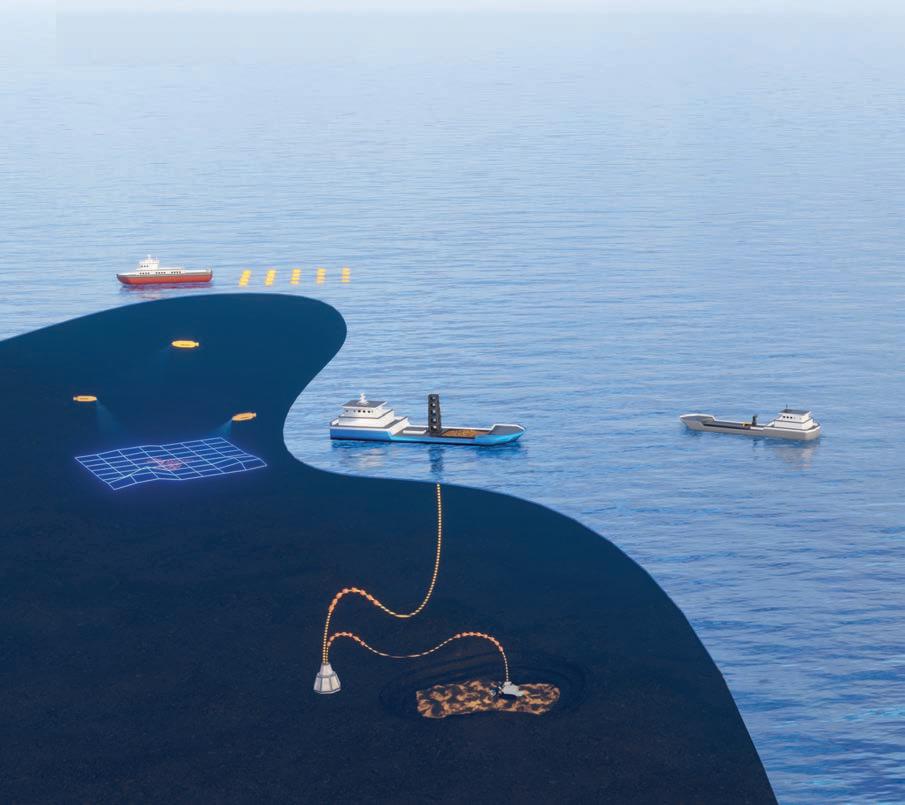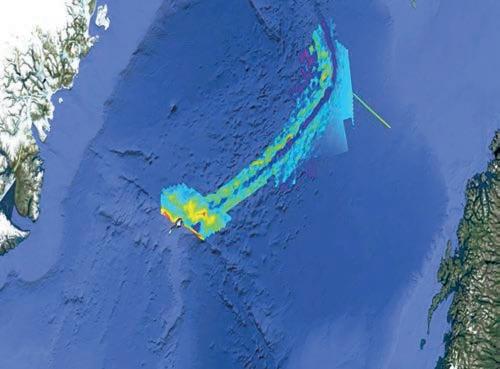
4 minute read
Green Minerals to target deep-sea mining
OSLO-LISTED SEISMIC COMPANY SEABIRD EXPLORATION IS SET TO EXPAND INTO SEABED MINING ON THE NORWEGIAN CONTINENTAL SHELF. WHILE SEABIRD WILL REMAIN DEDICATED TO MARINE ACQUISITION OF 2D/3D SEISMIC DATA AND OBN (OCEAN BOTTOM NODE) SERVICES TO THE OIL & GAS INDUSTRY, THE COMPANY AIMS TO SPIN OFF AND SEPARATELY LIST ITS MARINE MINERALS BUSINESS GREEN MINERALS.
ALL IMAGES COURTESY OF GREEN MINERALS. We are frm believers that oil & gas will have a role to play in the global energy transiton over the coming decades. SeaBird’s focus will therefore be to contnue developing and delivering cost-efectve, high-quality seismic services with the least amount of environmental impact for operators and their license partners. However, strategically and operatonally it makes sense to develop the marine minerals business as a standalone entty, given the
Advertisement
Seabed minerals can contribute to a greener and more sustainable future. They also represent a unique opportunity to establish a new ocean industry.

opportunity for value creaton we see in this market with an estmated USD 83 billion worth of resource potental on the NCS alone”, says Ståle Rodahl, Executve Chairman of SeaBird and Green Minerals.
Green shift
Moving the world from its reliance on fossil fuels to renewable energy will increase the demand for minerals to support the green shif. Such minerals are central to renewable technologies such as bateries, wind turbines, solar panels, but also the electrical infrastructures for power distributon. Some of these metals are a source of concern due to uncertain future supply, either due to inadequacy between future demand/supply projectons or because their current supply is currently limited to a few countries. Improved recycling eforts will only cover the growing future demand for metals. Producton at onshore mines is challenged by controversial working conditons and puts severe stress on resources and the environment. Marine minerals can raise the supply of raw minerals and reduce the environmental impact of mineral mining.
Norway prepares for seabed mineral exploration
On 12 January, the Norwegian government announced the start of a public consultaton period for an environmental impact study, >>

Ståle Rodahl, Executive Chairman of Seabird and Green Minerals.
which is required to open areas for mineral mining actvites on the Norwegian contnental shelf. The public consultaton follows three years of seabed mapping conducted by the Norwegian Petroleum Directorate. The directorate’s surveys have found signifcant deep-sea deposits containing copper, zinc, cobalt, gold, and silver. High concentratons of lithium and scandium, a rare-earth metal used in electronics, have also been discovered. Norway plans to start awarding producton licenses for deep-sea mining by 2023.
Unique opportunity
“Such seabed minerals can contribute to a greener and more sustainable future. They also represent a unique opportunity to establish a new ocean industry based on a home-market with signifcant export potental. This new industry could generate thousands of jobs and create signifcant value for Norway. Given our long-standing experience operatng on the Norwegian contnental shelf, Green Minerals is perfectly suited to play a key role in marine mining. But for Norway to take a pole positon in the development of seabed mineral exploraton, we must act now, while the global market is stll in its infancy”, says Mr Rodahl. According to a recent report from Rystad Energy consultng group, a Norwegian marine minerals industry could generate a yearly revenue up to USD 20 billion – compared to USD 61 billion for oil & gas in 2019 – and create about 21,000 jobs.

NPD’s surveys have found signifcant deposits of valuable minerals on the Norwegian continental shelf.
Leveraging oil & gas technology
SeaBird’s forthcoming spin-of Green Minerals is currently developing marine mining solutons combining feld-proven technologies from both the mining and deep-water oil & gas industries with an objectve of optmising the value generated by marine mineral deposits. “It is obvious that subsea mining shares common traits with deep-water oil & gas and onshore mining. Nevertheless, we recognise that subsea mining is a new industry and we are working towards providing optmal solutons that capitalise on existng experience and provide the necessary innovaton. There has been a great deal of discussion in recent years about how we can apply the highly valuable ofshore oil & gas industry competence to new, more sustainable industries. Green Minerals will provide the correct answer to that challenge,” adds Mr Rodahl.
Responsible operations
For marine mining exploraton purposes, Green Minerals will combine well-proven technologies such as high-resoluton seismic, bathymetry, electromagnetc surveys, magnetometry, water chemistry, hyperspectral imaging, as well as core and surface sampling supported by low-cost drilling solutons. “Green Minerals will be an advocate for responsible marine operatons, operatng with the smallest possible environmental footprint and ensuring that the highest value is produced from marine deposits. By transferring the oil & gas industry’s proactve approach to HSE to the ofshore mining industry, we can contribute to responsible mining operatons,” Mr Rodahl concludes.
SeaBird plans to spin of and list Green Minerals on Euronext Growth in Oslo in the frst quarter of 2021, making it the only pure-play marine minerals company that is listed. Following the spin-of and share distributon to SeaBird’s shareholders, SeaBird will be the majority owner of Green Minerals.










